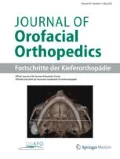Zusammenfassung
Bei der bogengeführten Zahnbewegung geht stets ein Teil der Kraft durch Friktion verloren. Zur quantitativen Bestimmung des Kraftverlustes wurde eine Apparatur eingesetzt, die die bogengeführte Zahnbewegung mit Hilfe eines dreidimensional beweglichen Zahns simuliert. Fünf verschiedene Drahtlegierungen in fünf Dimensionen wurden in Kombination mit drei verschieden breiten Brackets vermessen. Unter günstigen Verhältnissen beträgt das Verhältnis von angelegter zu orthodontisch wirksamer Kraft 2,3. Die erzeugte Friktion verhält sich proportional zum vertikalen Drahtdurchmesser. Breitere Brackets erzeugen weniger Friktion als schmale. Die von den verschiedenen Legierungen erzeugte Friktion ist deutlich verschieden. Wichtigste Materialeigenschaft zur Minimierung der Friktion ist die Oberflächenrauhigkeit.
Summary
Employing arch guided tooth movement always results in a loss of force by friction. In order to quantify the loss of force, an apparatus was designed featuring a simulated tooth with full three dimensional mobility. Five different wire alloys in five wire dimensions were combined with three brackets of different widths. Under optimal circumstances the ratio of applied force to orthodontically effective force was 2.3. In respect to the wire dimension the generated friction primarily depends on the vertical diameter. Wide brackets generate less friction than narrow ones. There are significant differences between the examined wire alloys. To minimize friction, a low surface roughness is of high importance.
Literatur
Andreasen, G. F., S. E. Bishara: Comparison of alastic chains and elastics involved with intra-arch molar to molar forces. Angle Orthodont. 40 (1970), 151–158.
Andreasen, G. F., R. E. Morrow: Laboratory and clinical analysis of Nitinol wire. Amer. J. Orthodont. 73 (1978), 142–151.
Andreasen, G. F., F. R. Quevedo: Evaluation of friction forces in the 0.022×0.028 edgewise bracket in vitro. J. Biomech. 3 (1970), 151–160.
Bishara, S. E.: A comparison of time related forces between plastic alastics and latex elastics. Angle Orthodont. 40 (1970), 319–328.
Blume, R. F.: An in vitro study of frictional forces in the.022×.028 edgewise bracket. Master's thesis. The University of Texas Health Science Center at Houston, Dental Branch, Houston, Texas 1975.
Böge, A.: Formeln und Tabellen zur Mechanik und Festigkeitslehre. Vieweg & Sohn, Braunschweig-Wiesbaden 1983.
Brantley, W. A., C. L. Augat, C. L. Myero, R. V. Windus: Binding deformation studies of orthodontic wires. J. Dent. Res. 57 (1978), 609–615.
Burstone, C. J., A. J. Goldberg: Beta titanium, a new orthodontic alloy. Amer. J. Orthodont. 77 (1980), 121–132.
Charles, C. R., D. Orth, M. L. Jones: Canine retraction with the edgewise appliance — some problems and solutions. Brit. J. Orthodont. 9 (1982), 194–202.
Creekmore, T. D.: The importance of interbracket width in orthodontic tooth movement. J. Clin. Orthodont. 10 (1976), 530–534.
Drescher, D., W. Laaser, H. A. Schumacher: Materialtechnische Untersuchungen zum Problem der Friktion zwischen Bracket und Bogen. Fortschr. Kieferorthop. 50 (1989), 256–267.
Frank, C. A.: An evaluation of frictional force generated between orthodontic bracket and arch wire. Master Thesis, St. Louis University 1979.
Frank, C. A., J. R. Nikolai: A comparative study of frictional resistances between orthodontic bracket and arch wire. Amer. J. Orthodont. 78 (1980), 593–609.
Garner, R. J.: A comparison of frictional froces during simulated canine retraction of a continuous arch wire. Amer. J. Orthodont. 90 (1986), 199–203.
Hershey, H. G.: The plastic module as an orthodontic tooth-mooving mechanism. Amer. J. Orthodont. 67 (1975), 555–562.
Muirhead, R. S.: A comparison of frictional resistance in the single and twin Edgewise brackets. Master's Thesis. The University of Texas Health Science Center at Houston, Dental Branch, Houston, Texas 1980.
Nikolai, R. J.: Bericht an Fa. Forestadent, Pforzheim, über die vergleichende Reibung Draht-Bracket. University St. Louis, Medical Center 1985.
Peterson, L., R. Spencer, G. F. Andreasen: A comparison of friction resistance for Nitinol and stainless steel wire in edgewise brackets. Quint. Int. (1982), 563–565.
Riley, J. L., S. G. Garret, P. C. Moon: Frictional forces of ligated plastic and metal edgewise brackets. Virginia Commonwealth University, Medical College of Virginia, Richmond 1979.
Author information
Authors and Affiliations
Rights and permissions
About this article
Cite this article
Drescher, D., Bourauel, C. & Schumacher, H.A. Der Kraftverlust durch Friktion bei der bogengeführten Zahnbewegung. Fortschritte der Kieferorthopädie 51, 99–105 (1990). https://doi.org/10.1007/BF02164847
Received:
Issue Date:
DOI: https://doi.org/10.1007/BF02164847

